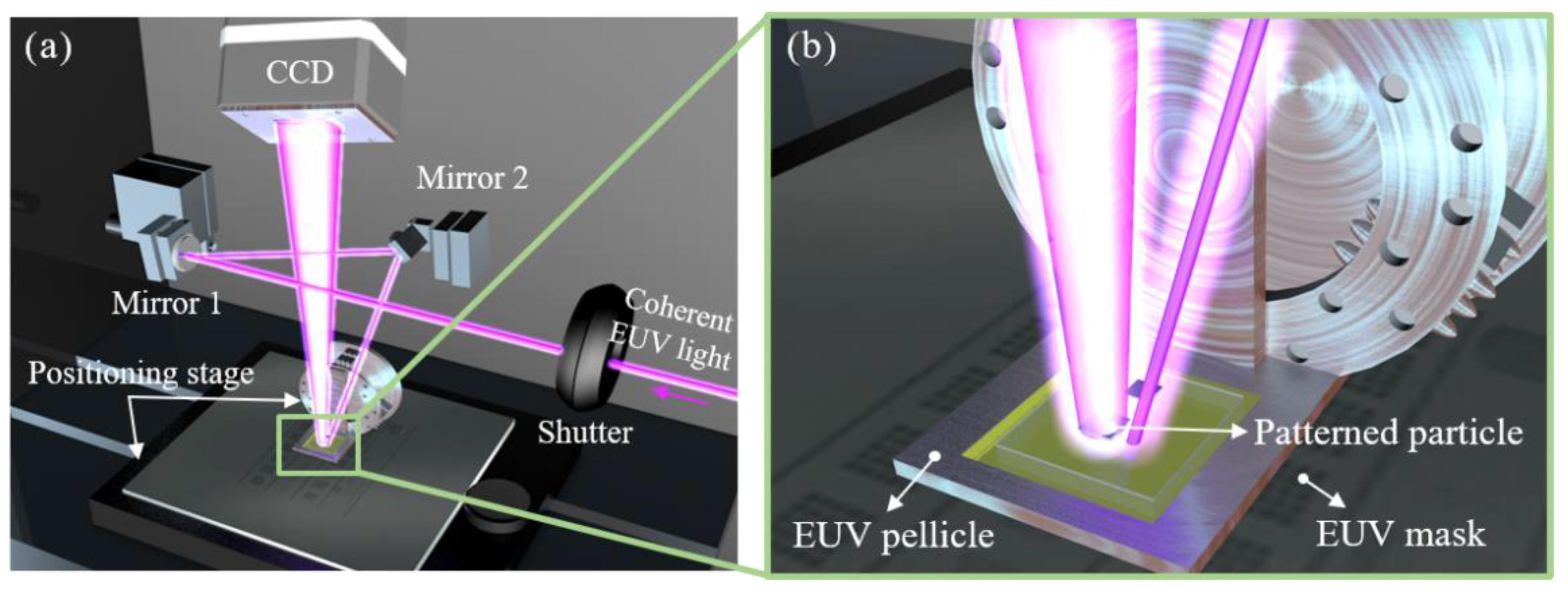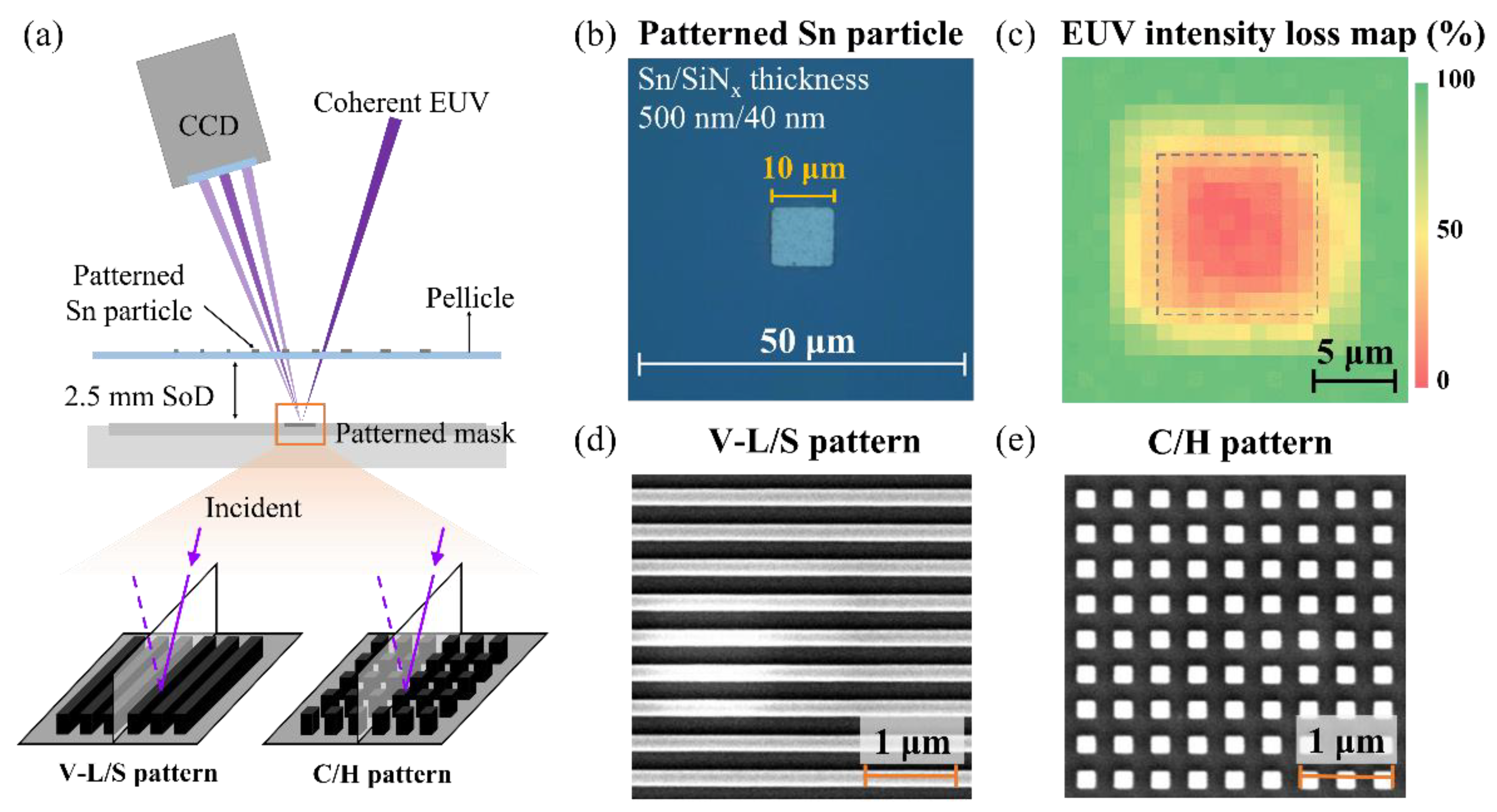Impact of Sn Particle-Induced Mask Diffraction on EUV Lithography Performance Across Different Pattern Types
Abstract
1. Introduction
2. Experimental Details
3. Results and Discussion
3.1. Deformation of Mask Diffraction Pattern Due to Particle-Induced Scattering
3.2. Comparison of Reconstructed Images with and Without Particle Obstruction
4. Conclusions
Author Contributions
Funding
Institutional Review Board Statement
Informed Consent Statement
Data Availability Statement
Acknowledgments
Conflicts of Interest
Abbreviations
| EUV | Extreme ultraviolet |
| CCD | Charge-coupled device |
| NA | Numerical aperture |
| V-L/S | Vertical line-and-space |
| C/H | Contact hole |
| OPL | Optical path length |
| CD | Critical dimension |
| PRTF | Phase retrieval transfer function |
References
- van de Kerkhof, M.; Klein, A.; Vermeulen, P.; van der Woord, T.; Donmez, I.; Salmaso, G.; Maas, R. High-transmission EUV pellicles supporting >400 W source power. In Proceedings of the SPIE Optical EUV Nanolithography, San Jose, CA, USA, 27 February–3 March 2022; Volume 12051, p. 120510B. [Google Scholar] [CrossRef]
- Kupers, M.; Rispens, G.; Devaraj, L.; Bottiglieri, G.; van den Hoogenhoff, T.; Broman, P.; Erdmann, A.; Wahlisch, F. Particle on EUV pellicles, impact on LWR. In Proceedings of the SPIE International Conference on Extreme Ultraviolet Lithography, Monterey, CA, USA, 15–19 September 2019; Volume 11147, pp. 102–115. [Google Scholar] [CrossRef]
- Brouns, D.; Bendiksen, A.; Broman, P.; Casimiri, E.; Colsters, P.; Delmastro, P.; de Graaf, D.; Janssen, P.; van de Kerkhof, M.; Kramer, R.; et al. NXE pellicle: Offering a EUV pellicle solution to the industry. Proc. SPIE 2016, 9776, 97761Y. [Google Scholar] [CrossRef]
- van de Kerkhof, M.; Klein, A.; Seoane, B.; Vermeulen, P.; Gallagher, E.; Timmermans, M.Y.; Pollentier, I.; Bekaert, J. EUV pellicle scanner integration for N2 nodes and beyond. In Proceedings of the SPIE Optical EUV Nanolithography, San Jose, CA, USA, 26 February–2 March 2023; Volume 12494, p. 124940D. [Google Scholar] [CrossRef]
- Licheri, S. Offline Study of Next Generation EUV Pellicle Materials and Performances: From Experimental Design to Material Characterization. 2019. Available online: https://www.diva-portal.org/smash/record.jsf?pid=diva2%3A1333546&dswid=3338 (accessed on 15 January 2025).
- Devaraj, L.; Bottiglieri, G.; Erdmann, A.; Wählisch, F.; Kupers, M.; van Setten, E.; Fliervoet, T. Lithographic effects due to particles on high-NA EUV mask pellicle. In Proceedings of the SPIE 35th European Mask and Lithography Conference (EMLC 2019), Dresden, Germany, 17–19 June 2019; Volume 11177, pp. 119–132. [Google Scholar] [CrossRef]
- Fomenkov, I.; Brandt, D.; Ershov, A.; Schafgans, A.; Tao, Y.; Vaschenko, G.; Rokitski, S.; Kats, M.; Vargas, M.; Purvis, M.; et al. Light sources for high-volume manufacturing EUV lithography: Technology, performance, and power scaling. Adv. Opt. Technol. 2017, 6, 173–186. [Google Scholar] [CrossRef]
- van de Kerkhof, M.A.; van Empel, T.; Lercel, M. Advanced particle contamination control in EUV scanners. In Proceedings of the SPIE International Conference on Extreme Ultraviolet Lithography, Monterey, CA, USA, 15–19 September 2019; Volume 10957, pp. 191–203. [Google Scholar] [CrossRef]
- Pollentier, I.; Timmermans, M.Y.; Huyghebaert, C.; Brems, S.; Gallagher, E.E. The EUV CNT pellicle: Balancing material properties to optimize performance. Proc. SPIE 2020, 11323, 113231G. [Google Scholar] [CrossRef]
- Scholze, F.; Laubis, C.; Krumrey, M.; Timmermans, M.Y.; Pollentier, I.; Gallagher, E.E. EUV optical characterization of alternative membrane materials for EUV pellicles. Proc. SPIE 2017, 10451, 104510R. [Google Scholar] [CrossRef]
- Brouns, D. Development and performance of EUV pellicles. Adv. Opt. Technol. 2017, 6, 221–227. [Google Scholar] [CrossRef]
- Pollentier, I.; Vanpaemel, J.; Lee, J.U.; Adelmann, C.; Zahedmanesh, H.; Huyghebaert, C.; Gallagher, E.E. EUV lithography imaging using novel pellicle membranes. In Proceedings of the SPIE Extreme Ultraviolet (EUV) Lithography VII, San Jose, CA, USA, 21–25 February 2016; Volume 9776, pp. 587–600. [Google Scholar] [CrossRef]
- Salmaso, G.; Maas, R. A new generation EUV pellicle to enable future EUV lithographic nodes at enhanced productivity. In Proceedings of the SPIE International Conference on Extreme Ultraviolet Lithography, Online, 27 September–1 October 2021; Volume 11854, p. 118540R. [Google Scholar] [CrossRef]
- Woo, D.G.; Kim, Y.W.; Jang, Y.J.; Wi, S.J.; Ahn, J. Through-pellicle imaging of extreme ultraviolet mask with extreme ultraviolet ptychography microscope. J. Micro Nanolithogr. MEMS MOEMS 2019, 18, 034005. [Google Scholar] [CrossRef]
- Kim, Y.W.; Lee, D.G.; Moon, S.; Ku, C.M.; Cho, J.H.; Ahn, J. Actinic patterned mask imaging using extreme ultraviolet ptychography microscope with high harmonic generation source. Appl. Phys. Express 2022, 15, 076505. [Google Scholar] [CrossRef]
- Levinson, H.J. High-NA EUV lithography: Current status and outlook for the future. Jpn. J. Appl. Phys. 2022, 61, SD0803. [Google Scholar] [CrossRef]
- Gardner, D.F.; Tanksalvala, M.; Shanblatt, E.R.; Zhang, X.; Galloway, B.R.; Porter, C.L.; Karl, R.; Bevis, C.; Adams, D.E.; Kapteyn, H.C.; et al. Subwavelength coherent imaging of periodic samples using a 13.5 nm tabletop high-harmonic light source. Nat. Photonics 2017, 11, 259–263. [Google Scholar] [CrossRef]
- Levinson, H.J. Principles of Lithography; SPIE Press: Bellingham, WA, USA, 2005. [Google Scholar] [CrossRef]
- Gouesbet, G.; Gréhan, G. Generalized Lorenz-Mie Theories; Springer: Berlin/Heidelberg, Germany, 2011. [Google Scholar] [CrossRef]
- Frisvad, J.R. Phase function of a spherical particle when scattering an inhomogeneous electromagnetic plane wave. J. Opt. Soc. Am. A Opt. 2018, 35, 669–680. [Google Scholar] [CrossRef] [PubMed]
- Frisvad, J.R.; Revall, J.; Christensen, N.J. Computing the scattering properties of participating media using Lorenz-Mie theory. In Proceedings of the ACM SIGGRAPH, San Diego, CA, USA, 5–9 August 2007; p. 60. [Google Scholar] [CrossRef]
- Nieto-Vesperinas, M. Fundamentals of Mie scattering. In Dielectric Metamaterials; Woodhead Publishing: Sawston, UK, 2020. [Google Scholar] [CrossRef]
- Cserti, J.; Áron, H.; László, O. Snell’s law in multirefringent systems. Phys. Rev. B 2025, 111, L041110. [Google Scholar] [CrossRef]
- Ziwei, L.; Lina, S.; Tanchao, P.; Hailiang, L.; Jiebin, N.; Guanya, W.; Changqing, X. Two-dimensional gratings of hexagonal holes for high-order diffraction suppression. Opt. Express 2017, 25, 1339–1349. [Google Scholar]
- van Setten, E.; Bottiglieri, G.; McNamara, J.; van Schoot, J.; Troost, K.; Zekry, J.; Fliervoet, T.; Hsu, S.; Zimmermann, J.; Roesch, M.; et al. High NA EUV lithography: Next step in EUV imaging. Proc. SPIE 2019, 10957, 1095709. [Google Scholar] [CrossRef]
- Goodman, J.W. Introduction to Fourier Optics; Roberts and Company Publishers: Greenwood Village, CO, USA, 2005. [Google Scholar]
- Naulleau, P.; Anderson, C.N.; Chao, W.; Goldberg, K.A.; Gullikson, E.; Salmassi, F.; Wojdyla, A. Ultrahigh efficiency EUV contact-hole printing with chromeless phase shift mask. In Proceedings of the SPIE Photomask Japan, Yokohama, Japan, 6–8 April 2016; Volume 9984, p. 99840P. [Google Scholar]









| Mask Pattern | Obstructed Diffraction Order | Maximum Intensity Loss |
|---|---|---|
| V-L/S | Zeroth-order | 85.4% |
| First-order | 86.4% | |
| C/H | Zeroth-order | 85.9% |
| Horizontal first-order | 87.9% | |
| Diagonal first-order | 88.2% |
Disclaimer/Publisher’s Note: The statements, opinions and data contained in all publications are solely those of the individual author(s) and contributor(s) and not of MDPI and/or the editor(s). MDPI and/or the editor(s) disclaim responsibility for any injury to people or property resulting from any ideas, methods, instructions or products referred to in the content. |
© 2025 by the authors. Licensee MDPI, Basel, Switzerland. This article is an open access article distributed under the terms and conditions of the Creative Commons Attribution (CC BY) license (https://creativecommons.org/licenses/by/4.0/).
Share and Cite
Moon, S.; Lee, D.G.; Choi, J.; Hong, J.; Lee, T.; Ekinci, Y.; Ahn, J. Impact of Sn Particle-Induced Mask Diffraction on EUV Lithography Performance Across Different Pattern Types. Photonics 2025, 12, 266. https://doi.org/10.3390/photonics12030266
Moon S, Lee DG, Choi J, Hong J, Lee T, Ekinci Y, Ahn J. Impact of Sn Particle-Induced Mask Diffraction on EUV Lithography Performance Across Different Pattern Types. Photonics. 2025; 12(3):266. https://doi.org/10.3390/photonics12030266
Chicago/Turabian StyleMoon, Seungchan, Dong Gi Lee, Jinhyuk Choi, Junho Hong, Taeho Lee, Yasin Ekinci, and Jinho Ahn. 2025. "Impact of Sn Particle-Induced Mask Diffraction on EUV Lithography Performance Across Different Pattern Types" Photonics 12, no. 3: 266. https://doi.org/10.3390/photonics12030266
APA StyleMoon, S., Lee, D. G., Choi, J., Hong, J., Lee, T., Ekinci, Y., & Ahn, J. (2025). Impact of Sn Particle-Induced Mask Diffraction on EUV Lithography Performance Across Different Pattern Types. Photonics, 12(3), 266. https://doi.org/10.3390/photonics12030266






